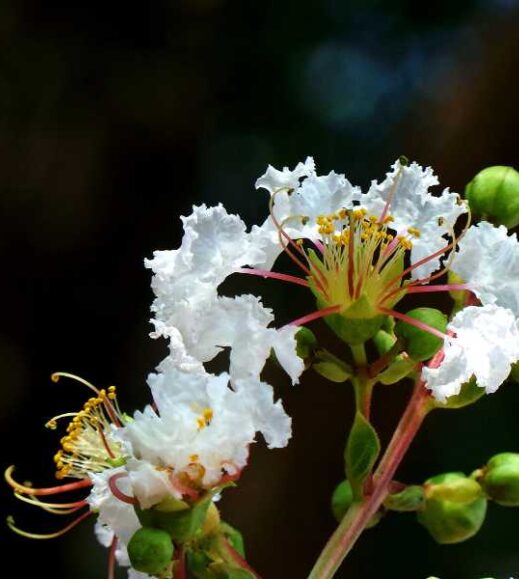Propagate | Soil | Light | Water | Temperature | Humidity | Potting | Pruning | Fertilize | Pest Control | FAQs
Whether you're a beginner gardener or a seasoned pro, knowing how to care for Acoma crape myrtle is essential for a thriving and beautiful plant. This guide will walk you through everything you need to consider while growing Acoma crape myrtle care, from planting and soil requirements to pruning and maintenance tips.
Looking for a beautiful and low-maintenance plant for your garden? Look no further than the Acoma crape myrtle! With its stunning pink flowers, glossy green leaves, and easy-to-care-for nature, this versatile plant is a must-have for any gardener. Whether you're a beginner or a seasoned pro, this Acoma crape myrtle care guide will help you to achieve a thriving and beautiful plant. From planting tips and soil requirements to pruning suggestions and maintenance advice, you'll find everything you need to know about taking care of your Acoma crape myrtle right here.
What is Acoma crape myrtle?
Acoma crape myrtle, also known as Acoma crepe myrtle, is a low-maintenance plant beloved by gardeners of all skill levels. With its stunning pink flowers, glossy green leaves, and easy-to-care-for nature, this versatile plant can be used in almost any part of your garden to achieve a lovely and vibrant look.
The origins of Acoma crape myrtle can be traced back to the southwestern United States, which was first cultivated by Native American tribes hundreds of years ago. Today, this beautiful plant is popular for its adaptability and resilience in various climates and conditions.
Dwarf Crape Myrtle Assortment, Pack of 5, White, Pink, Watermelon Red, Red & Purple, Matures 6'-10' (2-4ft Tall When Shipped, Well Rooted with Pots & Soil)
Do Acoma crape myrtle flower? What color is Acoma crape myrtle flower?
Acoma crape myrtle is known for its beautiful pink flowers, which bloom throughout the spring and summer. Depending on the climate and conditions, this plant may produce yellow or white flowers in addition to its iconic pink ones.
When to plant Acoma crape myrtle plant?
Acoma crape myrtle is a resilient, easy-to-care-for plant that can be planted in any season. However, the best time to plant your Acoma crape myrtle is early spring or late fall. During these cooler months, when temperatures are mild, and the soil is moist, your new plant will have an easier time establishing itself.
Types of Acoma crape myrtle: what are the recommended varieties of Acoma crape myrtle plant?
There are several varieties of Acoma crape myrtle, each with its distinctive characteristics. Some of the most popular varieties include:
Acoma Pink: This variety produces large, showy pink flowers and is known for its hardiness in various climates and conditions.
Acoma White: This beautiful white variety features stunning pale pink blooms that stand out against its bright green foliage.
Acoma Yellow: Brimming with vibrant yellow flowers all summer long, this variety is perfect for adding colorful pops of color to your garden landscape.
Acoma crape myrtle soil requirements: What is the best soil for Acoma crape myrtle plant?
The ideal soil conditions for Acoma crape myrtle are loose, well-drained, and slightly acidic. If your garden soil isn't right, simply amend it with compost or other organic matter to achieve optimal growth. Soil pH levels should be between 5.5 and 6.5 for the best results.
Make sure to use healthy soil that is free of disease. Adding amendments and enhancers to the soil can help improve plant growth.
Acoma crape myrtle light requirements: How much light does Acoma crape myrtle plant need?
Acoma crape myrtle thrives in full sun and can tolerate partial shade, making it a versatile choice for almost any garden. However, in areas with very hot summers or dry climates, you may want to provide some protection from the sun to avoid root damage or excessive moisture loss.
How to plant Acoma crape myrtle: What is the best way to plant an Acoma crape myrtle?
When planting your Acoma crape myrtle, make sure that the soil is well-drained and moist at a depth of about 12 inches. Gently dig a hole about twice as wide as the size of your plant's root ball, then place the plant at the same depth it was previously growing. Fill the hole with soil, then water thoroughly to help your new plant settle into its new home.
If you're looking to help your plants grow better under low light conditions, using plant grow light designed for specific plant wavelengths can improve growth.
Acoma crape myrtle water requirements: How often to water Acoma crape myrtle plant?
Acoma crape myrtle is a fairly drought-tolerant plant and only needs to be watered 2-3 times per week or as needed. Avoid over-watering your Acoma crape myrtle, as this can lead to root rot or other diseases.
The frequency of watering depends on the season and the specific environment. To water your plants most effectively, choose an irrigation system that suits their needs.
Acoma crape myrtle temperature range: What temperature can Acoma crape myrtle tolerate?
Acoma crape myrtle is a hardy, adaptable plant that can thrive in various temperatures. It can tolerate heat up to 90 degrees Fahrenheit in the summertime without any problems.
However, if you live in an area with particularly hot summers or cold winters, providing extra protection for your Acoma crape myrtles may be necessary. Planting them near other trees or shrubs can provide shade during the hottest days while using mulch and irrigation systems can help protect them from extreme cold.
Be sure to take measures to protect plants during bad weather. You can use a greenhouse, cold frame, and plant protective covers to create a protected environment for your plant that will help keep it healthy and happy year-round.
Acoma crape myrtle humidity: Do Acoma crape myrtle like humidity?
Acoma crape myrtle can tolerate various humidity levels, making it an ideal choice for gardens in humid and dry climates. However, if you live in an area with particularly high or low humidity, you may want to take extra measures to provide the right conditions for your plants.
Using a drip irrigation system or other watering methods for areas with very high humidity can help reduce leaf moisture and prevent root rot. Choosing drought-tolerant varieties and adding mulch to your garden bed for dry climates will help keep water levels optimal.
It is important to maintain the humidity of plants to prevent them from drying out or becoming too damp.
Where to buy Acoma crape myrtle plant?
Acoma crape myrtle plants can be found at many nurseries and garden centers. You can also order them online from a variety of online retailers. When looking for planting materials, look for plants that are healthy and free of pests or diseases. Always inspect the roots before purchasing your plant, and avoid any signs of rot or decay. Do your research beforehand to find reputable sellers with high-quality planting materials.
Acoma crape myrtle plant propagation: How to propagate Acoma crape myrtle plant?
Propagating plants is the process of creating new plants from existing ones. It's a great way to propagate your favorite varieties or save money by producing new plants for free. Several methods for propagating plants include seed propagation, stem cuttings, and propagation by division.
Propagate Acoma crape myrtle plant from seed:
One popular method of propagating plants is from seed. If you have an Acoma crape myrtle plant that produces seeds, you can collect and save them for future use.
To start the propagation process:
- Soak the seeds in water overnight to help them begin to sprout.
- Plant the seeds in a pot or container filled with moisture-retentive soil, and cover them with a plastic bag or other covers.
- Place the pot in an area that gets direct sunlight, and wait for your new seedlings to grow.
Another method of seed propagation is called "layering." To do this, bend a branch down until it touches the soil and then bury it, leaving just a few inches of the branch above the ground. After a few months, remove the branch and plant it in a pot to grow into a new plant.
Propagating Acoma crape myrtle plant by cutting:
Another method of propagating plants is by cutting. To do this, take a cutting from an existing plant and place it in the soil. Be sure to keep the cut portion above the soil line so that it can continue to get nutrients from the mother plant. After a few weeks or months, your new plant will have developed its own roots and can be transplanted into a pot or garden bed.
Propagating Acoma crape myrtle plant by division:
If you have a mature Acoma crape myrtle plant, you may be able to propagate it by division. To do this, dig up the plant and separate it into multiple smaller plants, making sure that each new cutting has at least one leaf or bud on it. Then replant the cuttings in pots or your garden bed and water regularly until they begin growing on their own.
Always start with good quality and healthy planting materials to make your Acoma crape myrtle plant thrive.
Potting Acoma crape myrtle plant
Once your Acoma crape myrtle plant is ready to be potted, choose a suitable container that provides plenty of room for the roots. Make sure that it has adequate drainage and is large enough to support your plant's size and growth rate.
Fill the pot with a potting mix designed for growing trees or shrubs, and add compost or other soil amendments as needed. Carefully place your Acoma crape myrtle in the pot, adding more soil under its roots as necessary to keep it upright. Water thoroughly after potting, taking care not to overwater or underwater your plant.
To ensure your Acoma crape myrtle plant thrives, it is important to select the correct pot size or container. You should also take care to consider the planting density and growing area.
How to prune Acoma crape myrtle plant?
Pruning is an essential part of gardening, as it helps to maintain the health and shape of your plants. There are various pruning tools on the market, including pruners, loppers, saws, and pruning shears.
When pruning an Acoma crape myrtle plant, it is important to be mindful of the overall shape that you are trying to create. For example, many opt for a balanced vase-like shape or a tree-like structure with multiple trunks and branches.
In addition to shaping your plant, pruning can also remove damaged or diseased branches and those that produce poor-quality flowers or foliage. To ensure that your cuts are clean and precise, use sharp pruning tools and follow proper safety precautions such as wearing thick gloves and goggles.
How to fertilize Acoma crape myrtle plant?
One of the best ways to keep your Acoma crape myrtle plant healthy and thriving is to fertilize it regularly. There are a variety of different fertilizers available, including organic or natural options, as well as chemical-based products.
When choosing a fertilizer for your Acoma crape myrtle plant, start by considering its growth stage. Younger plants typically require more frequent doses of fertilizer, while mature plants may need less frequent feedings or smaller amounts.
Other factors to consider when choosing a fertilizer include the pH level of your soil and any specific nutrient requirements that your particular plant might have. Talk to your local garden center or nursery for recommendations to get the most out of your fertilizer and ensure that you are not over-fertilizing your plant.
Choose a high-quality fertilizer with a balanced NPK (nitrogen, phosphorus, and potassium) ratio to fertilize your Acoma crape myrtle. Some of the plants also benefit by adding appropriate soil amendments.
Common Acoma crape myrtle diseases and how to manage Acoma crape myrtle disease?
Acoma crape myrtle plant is prone to a few common pests and diseases, including:
Powdery mildew: This fungal disease typically appears as a white powder or film on the leaves and stems of your Acoma crape myrtle plant. To manage powdery mildew, practice good sanitation by removing infected leaves and regularly spraying your plant with a fungicide.
Leaf scorch: Leaf scorch occurs when there is not enough moisture in the soil, resulting in dry and brown foliage. To prevent leaf scorch from affecting your Acoma crape myrtle plant, ensure that it receives plenty of water and check for signs of drought stress, such as wilting or curling leaves.
Scale insects: These small pests can cause serious damage to your Acoma crape myrtle plant by sucking the sap out of its foliage. To control scale insects, use horticultural oil or insecticidal soap to kill them. You can also try encouraging natural predators such as ladybugs, which will feed on eggs and nymphs of scale insects.
Taking good care of your Acoma crape myrtle plant is key to keeping it healthy and free from pests and diseases. Make sure you are watering your plant regularly, providing it with plenty of sunlight, and monitoring for signs of stress or damage. Additionally, practice good garden hygiene by removing any diseased leaves or debris, and take advantage of natural pest control methods whenever possible. Use good quality insecticides and fungicides if there is an outbreak of disease or pests. Always follow the instructions carefully to minimize any potential harm to your plants.
Takeaway on how to grow and care for Acoma crape myrtle plant
If you want to grow an attractive and healthy Acoma crape myrtle plant, there are a few things that you need to know. First, make sure that your plant receives plenty of sunlight and regular watering. This will help it to stay healthy and strong.
In addition to good care, another important factor in growing a healthy Acoma crape myrtle is choosing the right fertilizer. Choose a high-quality, balanced NPK fertilizer that will provide all the essential nutrients your plant needs.
Other considerations when growing an Acoma crape myrtle include monitoring for signs of pests or disease and using proper gardening techniques such as pruning, appropriate soil amendments, and pest control. With these tips, you can help your Acoma crape myrtle plant thrive and enjoy its beautiful blooms and lush foliage.
If you want to add some plants to your garden, explore our plant grow and care guides collection.
If you're new to gardening or a seasoned pro, join our supportive AgFunnel community of gardeners. Share a picture of your garden and receive support from fellow plant lovers.
Happy gardening!

How to master gardening? Download these essential home and gardening ebooks today!
FAQs
Where to put Acoma crape myrtle?
The best place for your Acoma crape myrtle plant is in full sun and well-draining soil. Make sure you are selecting a spot with plenty of room for this large shrub to grow, as it can reach up to 10 feet tall and wide.
How often should Acoma crape myrtle be watered?
It is important to water your Acoma crape myrtle regularly, especially during periods of hot or dry weather. The soil should be kept consistently moist and never allowed to dry out completely between watering. You may also want to consider using a mulch around the base of your plant, which will help to retain moisture in the soil.
How to get Acoma crape myrtle to bloom?
To get your Acoma crape myrtle plant to bloom, you need to provide it with the right growing conditions. This includes plenty of sunlight, moist soil, and regular fertilization throughout the growing season. You may also want to prune back older branches and stems, which can help promote new growth and stimulate the production of flowers.
Does Acoma crape myrtle plant like sun or shade?
Acoma crape myrtle plant prefers full sun and needs at least six hours of direct sunlight daily. However, it can also tolerate a bit of shade as long as it gets enough light during the middle part of the day. If your Acoma crape myrtle is not producing flowers or getting enough sunlight, try moving it to a different location or adding other sun-loving plants.
Is Acoma crape myrtle plant annual or perennial?
Acoma crape myrtle is a perennial shrub and will grow back year after year if it receives proper care. However, this plant can also be grown as an annual if you live in a colder climate or are not able to overwinter it indoors during the winter months.
Does Acoma crape myrtle plant come back every year?
Yes, Acoma crape myrtle will typically come back yearly if it receives enough light and water. Additionally, you can help to encourage new growth and blooms by regularly pruning the plant, fertilizing throughout the growing season, and mulching around the base of your plant.
Are Acoma crape myrtle plants toxic to cats?
While Acoma crape myrtle is not typically toxic to cats, it can cause gastrointestinal distress and other health problems if ingested. If your cat has been exposed to this plant, monitor them closely for symptoms such as vomiting, diarrhea, or lack of appetite. If you notice any of these issues, take your cat to the vet for immediate medical attention.
Are Acoma crape myrtle plants toxic to dogs?
In general, Acoma crape myrtle plants are not considered toxic to dogs. However, they can cause gastrointestinal problems if ingested, so it is important to keep your dog away from this plant if possible. If your dog has eaten part of a crape myrtle plant, monitor them for any symptoms such as vomiting or diarrhea, and take them to the vet if necessary.
Are Acoma crape myrtle plants toxic to pets?
Yes, Acoma crape myrtle plants are toxic to both cats and dogs. Ingestion of this plant can cause gastrointestinal distress and other health issues such as vomiting and diarrhea. If your pet has eaten any part of a crape myrtle, monitor them for these symptoms and take them to the vet if necessary.
How cold can Acoma crape myrtle plant tolerate?
Acoma crape myrtle plants can tolerate temperatures down to around 20 degrees Fahrenheit, making them suitable for growing in most regions of the US. However, they may not survive cold winters if they are planted outdoors or placed in areas that do not get enough sunlight. If you live in a colder climate, providing your Acoma crape myrtle plant with plenty of warmth and light during the winter months is important.
How often to water the Acoma crape myrtle plant?
Acoma crape myrtle plant typically needs to be watered about once a week, making it important to check the soil for moisture before watering. You can also use mulch or other methods to help retain soil moisture and keep your plant hydrated throughout the growing season. Additionally, it is important to water Acoma crape myrtle plants more frequently during hot, dry weather.
When to stop watering the Acoma crape myrtle plant?
Generally, Acoma crape myrtle plants should be watered regularly throughout the growing season, usually about once a week. It is important to stop watering your plant once the soil becomes too wet or you notice signs of overwatering, such as wilting leaves or developing mold or fungus. Depending on temperature and soil type, this may happen anywhere between once and twice a week. Ultimately, the best way to determine when to stop watering your Acoma crape myrtle plant is to check the soil moisture regularly and adjust your watering schedule accordingly.
Can I Use the Same Care Techniques for Growing Almond Trees to Grow Acoma Crape Myrtle?
Yes, the same growing almond trees care techniques can be used to grow Acoma Crape Myrtle. Both plants require well-draining soil, regular watering, and proper pruning to thrive. However, it's important to consider the specific needs of each plant as well.
When to fertilize the Acoma crape myrtle plant?
The best time to fertilize your Acoma crape myrtle plant is typically in the spring, about 2-3 weeks after new growth appears. However, you may also need to fertilize throughout the growing season if your plant does not appear to get enough nutrients from the soil. This is especially true if your plant is growing in a pot or container, as the soil may not provide all of the nutrients that your plant needs to thrive. To fertilize your Acoma crape myrtle plant, apply a fertilizer specially designed for use with shrubs and trees according to the instructions on the label.

















